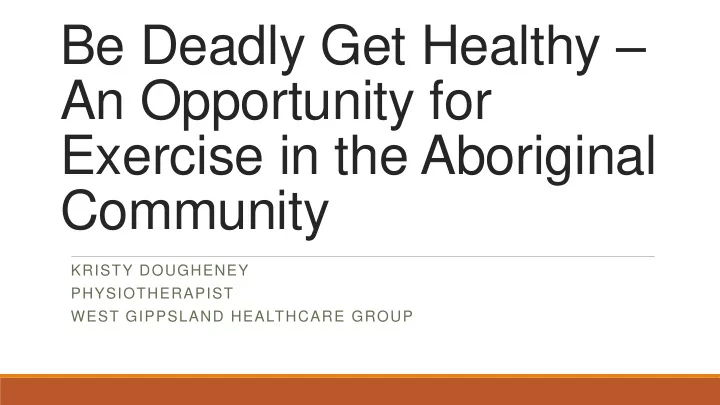

Be Deadly Get Healthy – An Opportunity for Exercise in the Aboriginal Community KRISTY DOUGHENEY PHYSIOTHERAPIST WEST GIPPSLAND HEALTHCARE GROUP
What is Be Deadly Get Healthy? Be Deadly Get Healthy is a community driven exercise program for the Aboriginal community based in the Baw Baw Shire. Developed to help prevent and manage chronic disease in the Aboriginal community Run by a physiotherapist and an Aboriginal Allied Health assistant
Background The Aboriginal population of the Baw Baw shire represents 0.9% of the population (Australian Bureau of Statistics, 2012). Aboriginal people are 13.9 times more likely to be admitted to hospital for complications relating to diabetes (Victorian Department of Health, 2012) Aboriginal people are 4.4 times more likely to be admitted due to cardiovascular disease (Victorian Department of Health, 2012) In rural Victoria 26.5% of Aboriginal people do not meet the national physical activity guidelines (Department of Health, 2011)
Background Physical inactivity is a modifiable risk factor for 5 out of 8 National health priority areas (Australian Institute of Health and Welfare, 2012) Physical inactivity accounts for one fifth of the burden of disease in Australia(Begg et al., 2007). Picture used with permission of participant
Aims of the program To deliver a family focused, community lead program. To provide training to develop local Aboriginal health care workers To change exercise behaviours in context of chronic disease management and prevention. To break down barriers between the Aboriginal community and local medical services. To address barriers to exercise participation. To maintain and increase participation in the program to ensure sustainability.
Method Discussion was held with the local elders to determine the need/ desire for a physical activity program Funding was obtained Community consultation sessions completed Barriers to exercise were identified and overcome Venue was selected by the local elders
Method Referrals were received from the local Aboriginal health service, GP’s community consultation sessions and word of mouth. Initial assessments were completed and included - General medical information - Limitations including barriers and physical issues - General screen for other allied health services - Australian Diabetes Risk Assessment (AUSDRISK) - Social Support for exercise survey Weekly program was commenced to suit needs of community
Results - Participants 32 participants (24 adults, 8 children) Participants range in age from 2 years old – 67 years old 18 adult females, 6 adult males
Results – Physical Activity All participants increased their intensity, frequency and duration of exercise 4 participants met the Department of Health national physical activity guideline requirements Photo used with permission of participants
Results - AUSDRISK 3 participants were known to have diabetes 50 % decreased their AUSDRISK Diabetes risk score Those that decreased their WC did not lose enough weight to decrease them to the required level.
Results – Social Support for Exercise All participants increased their social support for exercise scores
Successes Community days Obtaining further funding Aboriginal Allied health assistant learning new skills Building relationships with the local Aboriginal Health service and organisations within the community. Photo used with permission of participants
Challenges Make group culturally sensitive and safe Moving away from the medical model Overcoming the barriers to exercise Group had to become more flexible in it’s approach Males believing it is a ‘women’s group’ Varied abilities of participants Inconsistent attendance Original facility being demolished and having to relocate the program
Case Presentation 50 year old female 153 kg, BMI 56.7, WC 147cm 10 minutes of low intensity exercise 7 days a week AUSDRISK score 28 Social support score: family 13, social support score: friends 18
Case Presentation Referred to podiatrist and dietitian Weekly transport organised Started exercising daily - Walking laps of street, arm and leg strengthening exercises 30-40 min a day Met the National Physical Activity Guidelines Lost a total of 28kg Social support score for family increased to 30 and for friends to 25
Moving Forwards Continue to liase with community and elders about needs of the community Hope to obtain further funding Incorporate more cultural based activities Continue to develop Aboriginal health workers skills and knowledge Provide more support to participants to encourage them to Wayapa Wuurrk leaders Jamie Thomas and Sara Jones running Wayapa session – Photo used with permission of participants quit smoking
References Australian Bureau of Statistics (2012). 2011 Census community profiles, from http://www.censusdata.abs.gov.au/censusservices/getproduct/census/2011/communityprofile/LGA2 0830?opendocument&navpos=230 Australian Government Department of Health (2014). Australian Physical Activity and Sedentary Behaviour Guidelines Australian Institute of Health and Welfare (2012). Health priority areas, from http://www.aihw.gov.au/risk- factors-health-priority-areas/ Department of Health (2011). The health and wellbeing of Aboriginal Victorians: Victorian Population Health Survey 2008 Supplementary report. Melbourne: State Government of Victoria. From http:// health.vic.gov.au/healthstatus/. Victorian Department of Health (2012). Gippsland health online indigenous health documents, from http://docs.health.vic.gov.au/docs/health-documents-by- category?OpenView&RestrictToCategory=Gippsland-health-online-Indigenous-Health
Recommend
More recommend